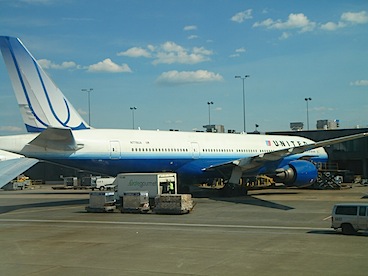Hubs, Spokes and Focus cities
Most airline use a Hub and Spoke model for their routes. What that means is that airlines have certain cities that are their hubs or home bases. All their routes have a hub city as at least one of the ends of any route they operate. So, no matter what city pair you pick, you will have a hub city in your routing, either as one or both of the ends of your journey or as a stopover. So, for example, if you live in Raleigh, NC (RDU) and are looking for flights to Las Vegas (LAS), as neither city is a hub for any airline, you will not be able to get a non-stop flight. You will have to go thru a hub city. Yes, I know, Las Vegas is a ‘focus city’ for US Airways, but I will talk about that later in this article. And yes, I did my fact checking, there are no non-stop flights from RDU to LAS.
The only exception to the hub and spoke model are some low cost airlines, such as Southwest, which do not use this model. They operate routes between specific city pairs. Very few major airlines with a hub and spoke model operate direct routes between non-hub cities.
Hub Airports:
Airlines use hubs to maximize the usage of their aircraft and to maximize the loads on their routes. As every route ends at a hub, they now have the aircraft available to be used on any other route that originates at that hub. Such a model also results in very heavy usage routes between hub city pairs. This allows airlines to have multiple flights between hub cities and can use larger aircraft. United airlines uses Boeing 767s and 777s on many flights between their their hub cities. In fact, they are currently using an old 747 for flights between San Francisco (SFO) and Chicago O’Hare (ORD).
Going by my earlier example of the RDU – LAS flight, all airlines using a hub and spoke model will route you thru one of their hub cities. If you buy this trip with United, they will route you thru one of their hub, Washington Dulles (IAD) for example. United, in this example, is able to use the RDU – IAD leg of the flight to feed passengers to any flight originating at IAD. And vice versa for the IAD – LAS leg. 
For most airlines, their hubs are also international gateways. So, all the flights leading into the hub also feed their international flights. The only exception I can think of is US Airways’ Phoenix, AZ (PHX) hub, which has no international flights originating at it. All of US Airways international flights originate at their Charlotte, NC (CLT) and Philadelphia, PA (PHL) hubs.
Multi-hub airports:
Some airports are hubs for multiple airlines. For example, Chicago’s O’Hare (ORD) airport is a hub for United and American Airlines and New York’s JFK airport (JFK) is a hub for Delta and American Airlines. This results in these airports become extremely busy. This also results in these airports becoming bottlenecks that can cause delays in the entire system. If there are delays at a hub airport, that airline’s multiple routes are impacted as all of their aircraft pass thru a hub. If such delays happen at a multi-hub airport like JFK or ORD, multiple airlines can end up having system-wide delays.
Overseas Hubs:
Some airlines also have hubs that are based outside their home country. For example, Delta has a hub in Tokyo’s Narita airport (NRT). Jet Airways has a hub in Brussels (BRU), Belgium. Air India has been talking about establishing a hub in Munich (MUC) Germany. Lufthansa has a hub in Milan (MXP) airport thru Lufthansa Italy. This is rare, but is becoming a growing occurrence as airline are looking for strategic hub locations to develop a global network.
Focus Cities:
Focus Cities are mini-hubs. The airline does not have a presence there to be designated a hub, but have significant hub-like operations based out of there. These airports usually have flight coming into them for most, if not all of their hubs and fanning out to near by locations. As I mentioned above, US Airways has Las Vegas (LAS) as a focus city. Another focus city for them is Washington DC’s National airport (DCA). United airline has Tokyo’s Narita airport (NRT) as a focus city with flight originating there for Singapore (SIN), Hong Kong (HKG), Bangkok (BKK), etc.
You can get regular updates via email or RSS by clicking on the RSS link here. I micro-blog onTwitter and Facebook on the Airline Industry, Airline Miles and other Loyalty Programs.

It sure looks like Southwest is starting to have hubs at cities like BWI, MDW, DEN, PHX and LAS. They offer lots of flights and lots of connecting itineraries. They sure look like hubs. Airtan has hubs at ATL and MKE. Jetblue hubs at JFK. So even the LCCs use hubs – because they create a much more powerful network.
Having two airlines operate a hub doesn’t necessarily create congestion. It all depends on the runway capacity of the airport and weather. Airports like IAH and DFW are often congested, mainly by the operations of CO and AA respectively. At JFK, DL and AA combined have well under 50% of the flights – the delays there are due to sheer volume of flights from a lot of airlines using it as a spoke, as well as DL, AA, and B6
Carl, very good information and insight. Thanks for sharing.
On the topic of multi-hub airports and congestion, I think when airports allow multiple airlines to operate hubs out of their airport, they should keep their capacity in mind. In my opinion, perpetually congested airports are not the airlines fault, but that of the airports that are selling slots without having enough runway/gate capacity.